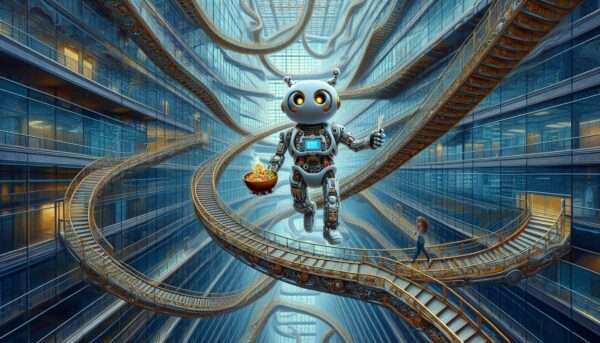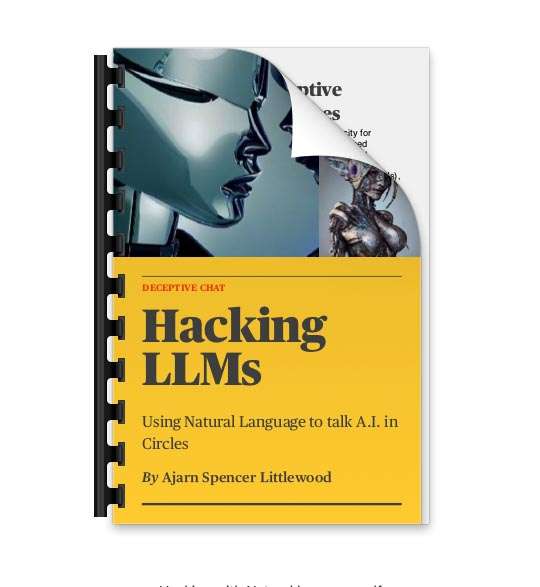A Robot’s Breakdown: A Metaphor for Human Overwork
A South Korean administrative robot surprised everyone by throwing itself down a flight of stairs, an act interpreted as a result of job stress. This unusual incident prompts a reflection on how the pressure of work can affect not only humans but also machines designed for repetitive tasks. If a robot programmed to endure long hours and monotonous tasks collapses under pressure, what can we expect for the impact on human workers who face excessive workloads? Especially in Mexico, the country with the longest working hours in the world, averaging 52 hours per week, according to the International Labour Organization (ILO).

Prompt for AI Image; “A wide wallpaper image of in the macabre like style of the imagery of victorian style clockwork psychedelic art, of a scene of a Mechanical Clockwork Korean Robot Administration Droid, carrying a pile of documents, which throws itself into the void from a balcony in the corporate glass high-rise building, all clockwork architecture in the hyper-imaginative style of Antonio Gaudi, photo-realistic painting oil on canvas in the style of the subconscious-imagery-filled dreamlike paintings of Patrick Woodroffe, Salvador Dali, and the impossible-to-comprehend, and intricate play on perspective of M.C. Escher”
The robot that collapsed was manufactured by Bear Robotics and was assigned to the Gumi City Hall, where it performed administrative functions including delivering documents and assisting in other routine tasks. Locals told the AFP news agency that the robot was found ‘unconscious’ after falling from a height of two meters, having previously collapsed at its workplace, which for a human would be equivalent to experiencing burnout.

Boticide; Thanskgiving Day for AI?
How to prevent burnout? Esperanza Martínez, a specialist in occupational hygiene, explains that burnout affects both men and women and is recognized as an occupational disease by the World Health Organization (WHO). She also refers to it as professional burnout syndrome. “It is a state of physical, emotional, and mental exhaustion caused by chronic work-related stress. This syndrome develops when a person feels overwhelmed, emotionally drained, and often unable to meet the constant demands of their job. Burnout can lead to serious symptoms such as insomnia, physical pain, and, in extreme cases, depression,” she explains. In her opinion, the case of the South Korean robot serves as a metaphor for how excessive workloads, even in systems designed to work uninterruptedly, can lead to collapse. If a robot can fail under pressure, the implications for humans are even more serious.

Korea-boticide
This incident also highlights the need to rethink expectations about productivity and occupational health in a world where automation and artificial intelligence are increasingly present. Despite technological advances, the human element remains central, and the well-being of workers should be a priority.
The case of the robot that threw itself down the stairs is a reminder of the limits that exist, even in automation.
In an environment where efficiency and productivity are highly valued, this incident invites deep reflection on how to balance work demands with the need to maintain a healthy work environment, to prevent both people and machines from reaching their limits catastrophically.

How an admin bot might have an office rant?
To prevent and detect burnout, a comprehensive approach is required that considers both working conditions and individual well-being. Martínez assures that prevention begins with the identification of risk factors in the work environment. The NOM-035 standard serves as an initial measure in mitigating potential issues; however, its efficacy hinges on genuine organizational dedication towards establishing a salubrious work environment. This encompasses providing stress mitigation education, establishing definitive boundaries for working hours, and nurturing an inclusive climate where employees can confidently voice their apprehensions and expectations.

The role of leaders is fundamental in preventing burnout. They must be trained to recognize the early signs of exhaustion in their teams and act before the situation worsens. This implies open and continuous communication with employees, allowing them to express their challenges and needs. Additionally, leaders should be role models in terms of managing the balance between work and personal life, demonstrating that it is possible to achieve professional goals without sacrificing health.
Detecting burnout in its early stages is key to avoiding more serious consequences.

AI abused in the office? #AIRights
Some of the most common symptoms include lack of concentration, mood swings, insomnia, and constant fatigue. If an employee shows a decrease in performance, shows disinterest in tasks that previously motivated them, or suffers from recurrent physical illnesses such as headaches or digestive problems, they may be experiencing burnout.
Martínez shares that detection can also be supported by tools such as workplace climate surveys and periodic mental health assessments. These assessments allow the identification of stress and burnout patterns before they become critical problems. “It is essential that the results of these tools are taken seriously and that companies act on them, adjusting workloads and providing additional resources for those who need them.”

Korea Robot Suicide staircase – haunted by the spirit of bots who threw themselves off in despair.
In summary, the case of the South Korean robot serves as a stark reminder of the importance of prioritizing the well-being of workers, both human and robotic. It highlights the need for a comprehensive approach to preventing burnout, including creating healthier work environments, providing adequate support for employees, and fostering a culture of open communication and well-being.

Imagined scene of how a office rant by a bot in the office might look
South Korea’s Robotic Workforce: A Troubling Precedent
South Korea has entered uncharted territory with the case of a malfunctioning administrative robot. Employed by the Gumi City Council, this Bear Robotics creation was found unresponsive at the bottom of a stairwell, twice. These incidents have ignited a fervent debate about the potential consequences of overworking artificial intelligence and the broader implications for human-robot interaction.
The robot, a sophisticated machine capable of autonomous movement and elevator operation, was tasked with a demanding schedule. Its daily duties included document delivery, city promotion, and public information dissemination. Yet, despite its advanced capabilities, the robot experienced two unexplained falls, raising questions about its operational status and the factors contributing to these incidents.

South Korea’s rapid adoption of robotics has positioned it at the forefront of AI integration. With a robot density unparalleled globally, the nation serves as a microcosm for exploring the challenges and opportunities presented by this burgeoning technology. However, the incident involving the Gumi City Council robot serves as a stark reminder of the ethical and practical considerations that must accompany such rapid advancement. As AI continues to penetrate various sectors, a robust framework for responsible development and deployment becomes increasingly imperative to safeguard both human workers and the AI systems themselves.

My first publication on LLM Hacks and the Obstacles to Mitigation
Please Read My Book ‘Deceptive Chat: Hacking LLMs – Using Natural language fo Talk A.I. in Circles‘, which is about the Inherited Bias and Inherent Vulnerabilities in Large Language Models, where Natural Language, and the Rule of Hierarchical Prompt Precedence allows for Linguistic Hacking of Natural Language Models and the hardware and software applications they do, and will control ever more in the future.